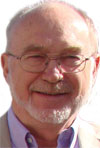
This month, I take a different look at how technology can be transferred between industries, and used to solve heart-wrenching problems. Always touted as the birthplace of new technology applications, Formula 1 racing constructor Williams Racing, based near Oxford, is actually saving 50 Sainsbury supermarket stores in the UK around 15% of their bill for electrical power. This is nothing to do with speeding up the shopping, but because they can make the refrigerated cabinets more efficient. Using the technology of the aerodynamically-efficient rear wing on the Williams F1 car, a similar aerofoil device attached to the front of the shelves in the refrigerator keeps the cool airflow inside the cabinet. An added benefit is that this makes the temperature in these cold aisles up to 4°C higher than before, making the customers happier – and maybe stay longer! The device is being manufactured by a spin-off company, Aerofoil Energy, and will be rolled out across 1400 of Sainsbury’s UK supermarkets.
Sir James Dyson, the British engineer and inventor responsible for novel designs of vacuum cleaner, hand-dryer and hairdryers, has announced that his company is developing an electric car, using his own expertise in electric motors and battery technology. He sees the major market for the car in Asia, and will use his air filtering technology to protect the occupants from the fumes from other vehicles on the road.
Following hard on the heels of this announcement, the first self-driving shuttle bus was introduced into regular service in Las Vegas. On the first day of operation, the bus was providing free trips round a 1 km loop, at 25 km/h max: during one circuit, it met a lorry doing an illegal reversing manoeuvre. As programmed, the bus detected the lorry and stopped, but the lorry driver (human) continued his move and hit the shuttle, damaging the front bumper. He received a ticket for ‘illegal backing’. No-one was hurt and the shuttle, which has no steering wheel or brake pedals, continued providing free trips round this loop for the rest of the day.
Motor neuron disease (MND)
MND, otherwise known as ALS, or Lou Gehrig’s disease, is a rapid muscle wasting auto-immune disease. Sufferers need mobility aids delivered quickly, as any delivery delay makes them no longer suitable. Typically the time span from diagnosis to death is two years, but the brain is unaffected throughout. The exception to this timescale, somehow, is Professor Stephen Hawking, the theoretical physicist at Cambridge, who is still alive after over 50 years. I saw him there, being wheeled along in his chair, working on a screen full of 0s and 1s, interrogating them by moving a facial muscle (in his cheek) which allows him to move a cursor. He comments: “I have experimented with eye tracking and brain-controlled interfaces to communicate with my computer. However, although they work well for other people, I still find my cheek operated switch easier and less fatiguing to use.” Work at Nottingham University has specialised in this area, and Prof. Hawking has helped their PhD students to test new systems.
It all started in 1997, when Hawking happened to meet Gordon Moore, the co-founder of Intel. Hawking lost his voice in 1985, when he contracted pneumonia and had an emergency tracheotomy. In ’97, he had an AMD processor for communication, so Moore fixed him up with an Intel microprocessor-based computer, and has worked with him ever since. A colleague contacted the CEO of WordsPlus, in California, who had developed a program (Equaliser) for a relative with ALS, to enable her to select commands and words. Equaliser was loaded onto an Apple device that drove a ‘SpeechPlus’ synthesiser. Hawking continued with conventional software behind his interface until 2012, when at 70 he was slowing down. An Intel team basically then loaded all his books and papers into the predictive text algorithms, a system known as ACAT (assistive contextually aware toolkit). As an example, when Hawking writes ‘the’, the system offers ‘black’, and then ‘hole’. This once more speeded up Hawking’s communications interface.

There are now many systems available for MND sufferers, to interface to emails and speech synthesis, using eye movement sensors such as those from Eyegaze. More importantly in a practical sense, is that these can also be used to drive and steer their wheelchair motors, to enable some semblance of independence and continued communication for the people living with these problems.
Nick Denbow spent 30 years as a UK-based process instrumentation marketing manager, and then changed sides – becoming a freelance editor and starting Processingtalk.com. Avoiding retirement, he published the INSIDER automation newsletter for five years, and then acted as their European correspondent. He is now a freelance Automation and Control reporter and newsletter publisher, with a blog on www.nickdenbow.com

© Technews Publishing (Pty) Ltd | All Rights Reserved